The Next Wave: Pharm Exec's 2011 Pipeline Report
42 of the best new drugs in development–or parked at the FDA
Like a mermaid or a minotaur, pharma's 2011 pipeline is a shape-shifting creature—a hybrid of primary care and specialty products; mass-market molecules and orphan-disease biologics; novel vaccines for neglected diseases that may save hundreds of thousands of lives at cost; and follow-on oncologics that may add a few months of survival with six-digit price tags for the few who can afford them. New forms of pharma life are rising out of the defunct blockbuster model, but they remain in morphing mode.

Getty Images / Sean Davey
The 42 compounds in Pharm Exec's "2011 Pharma Pipeline Report" reflect this evolutionary moment. The list of firsts, of significant advances and downright breakthroughs, is unusually promising. New classes of HIV-inspired protein inhibitors are set to increase the cure rate in Hepatitis C by 50 percent. In multiple sclerosis, the advent of new oral therapies and new approaches may dramatically cut disease progression. Patients with lupus will have the first new treatment in half a century, and better, safer bloodthinners will finally lay old warhorse warfarin to rest. The vaccine pipeline heralds first-ever prevention against such widely varied threats as malaria, MRSA bacteria, and anthrax. And in cancer a few new treatments have hit the bull's-eye on new targets and pathways, including previously untreatable triple-negative breast cancer and advanced melanoma, while a small group of non-small-cell lung cancer patients may have a Gleevec-like success story. Meantime, the anti-CETP inhibitors have risen from the grave, as several competing molecules, much-tweaked for safety, race to become the first-in-class good-cholesterol gooser—and rake in Lipitor-sized profits.
This list is testimony to a level of innovation any industry would be proud of. But there are some telling absences. CNS remains the black box of R&D. With Alzheimer's a looming public health crisis, the field is littered with Phase III failures, and the fate of the final two or three megablockbuster-to-be is in grave danger. Obesity resists pharmaceutical intervention. Even diabetes, however well treated, still lacks a truly disease-modifying drug.

Drug Index
Inevitably, the learning curve for pharma will remain steep for the foreseeable future. Only yesterday, it seems, the industry finally grasped that me-toos and marginal improvements no longer cut it. Drugmakers went mad for targets, screening and acquiring mountains of compounds in diseases they knew well and those they did not.
"The next innovation for pharma will come from a more comprehensive approach to disease," says Mike Wokash, a veteran of Big Pharma who blogs at Pharmareform.com. "Too many of the big players are still looking for a product in a market for next year rather than looking to make a real impact on a disease in five or 10 years." Now, with comparative effectiveness and price pressures in the offing, regulators, payers, and consumers are all demanding better value, guaranteed efficacy, and proven outcomes—and for pharma, chasing innovation demands more investment of all kinds than ever before.
Hyperlipidemia: The Anti-CETPs Redux
The crowded cholesterol-control category is the biggest US drug market, with 2010 global sales close to $35 billion, according to IMS Health. A wide array of me-too statins, either generic or soon to be so, already excel at lowering LDL, or "bad" cholesterol, leaving the increase of HDL, or "good" cholesterol, the only low-hanging fruit left in this orchard. Many studies have confirmed that high levels of high-density lipoproteins, which collect the artery-blocking low-density kind and carry them to the liver for expulsion, correlate to low risk of atherosclerosis and heart attack. But in 2006, Pfizer's first-in-class CETP inhibitor flamed out in spectacular Phase III fashion because it increased not only HDL but patient deaths—by 60 percent—mostly due to hormone-induced hypertension.
Most CETP-inhibitor programs were promptly shuttered, but Merck, Roche, and smaller shops quietly persevered, tweaking their molecules to minimize the perceived risk. Last month, Merck snatched the spotlight at the annual heart-association confab with study data showing that patients on a statin and its CETP inhibitor, anacetrapib, had a 40 percent greater reduction in bad cholesterol than the statin-only group. Yet the 'wow' factor was that its good cholesterol soared by 140 percent, while blood pressure and cardiac problems were no different from placebo. Said Christopher Cannon, a cardiologist at Brigham & Women's Hospital and the study's lead researcher: "If what we are seeing now is borne out in larger studies, this could be the next big thing that could benefit hundreds of millions of people."
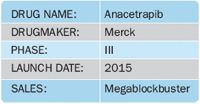
By contrast, Roche's Phase III anti-CETP contender, dalcetrapib, has demonstrated a weaker lipid punch, lifting HDL by 40 percent and lowering LDL by 15 percent. Other compounds are in the works to treat more serious disease.
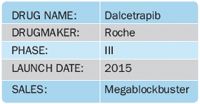
Quantity is one thing, quality another. Some skeptics have raised doubts about how well—or even if—drug-produced HDL functions. Whether these high marks translate into clinical benefits—must wait until 2015 at the conclusion of Merck's $150 million, 30,000-person Phase III study. If they do, Merck may have a Lipitor-sized cash cow in its pasture.
Acute Coronary Sydrome: A Risky Business
A new class of anticoagulants is competing to dethrone difficult-to-manage warfarin, long the sole option in the prevention of stroke and other bleeding complications in the 2.5 million US patients with atrial fibrillation. The novel bloodthinners are blockers of direct factor Xa, knocking out a specific enzyme in the coagulation cascade that takes place in veins. Bayer/J&J's Xarelto led the pack after filing data last month showing that in a Phase III trial of more than 14,000 patients, once-daily Xarelto reduced clots by 20 percent compared to warfarin.
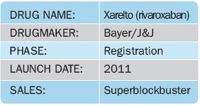
Asked for more data by the FDA, Xarelto lost the warfarin-replacement race to Boehringer Ingelheim's oral direct thrombin inhibitor, Pradaxa, which was approved in October. But the $15 billion market is big enough for both new products, plus the late-stage Factor XA inhibitors from Merck/Portola and Daiichi-Sanyko. Post-market studies will shake out the winners and losers. Yet the recent failure of Pfizer/BMS's apixaban in Phase III due to excessive bleeding risk illustrates the tightrope all novel anticlotting drugs must walk between efficacy and safety to get to market.
In the category of antiplatelets, which prevent blood clots in arteries, Plavix has long been king. But when the world's second-best-selling drug goes generic next year, a flood of cheap knockoffs will raise the bar for competitors to gain market share. Proving superiority as well as safety are the keys to the kingdom, and with 30 percent of all patients not responding to Plavix, new options are a must. AstraZeneca's Brilinta got an OK from the FDA's advisory committee last July, but a final decision has been delayed while the agency mulls over the anomaly of its global Phase III trial—the ADP receptor inhibitor proved superior to Plavix in reducing heart attacks, strokes, and deaths everywhere but in the US (the leading theory is that bloodthinning aspirin is used much more widely there than elsewhere).
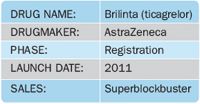
How brilliant is Brilinta's future? Consider that Lilly's Effient, the latest Plavix rival, has performed so dismally since its 2008 launch. But Brilinta's safety profile far outshines the Lilly drug—at least so far. "Brilinta is likely to succeed where Effient failed," says Wolters Kluwer's analyst Ben Weintraub.
In its ambition to seize control of the cardiovascular space from which some big pharmas have fled, Merck also has a big bet on antiplatelets with its first-in-class Phase III PAR-1 thrombin receptor inhibitor, vorapaxar, whose novel mechanism of action could set it apart from Brilinta, Plavix, and other targeters of ADP receptors. Robert Hazlett, an analyst at BMO Capital Markets, is bullish on the entire Merck cardio franchise, but especially vorapaxar, projecting $5 billion in peak annual sales.
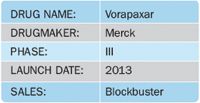
Diabetes: Agonists versus Inhibitors
Diabetes is pharma's second-largest global market, worth close to $25 billion and growing by double digits annually, even in the developed world. Competition among drugmakers is fierce, with hundreds of new compounds entering the pipeline each year despite the fact that the disease is already well treated, from first-line metformin to last-ditch injectable insulin. The space between is where the new drug action is.
Controlling glucose is no longer the exclusive therapeutic challenge. Says Datamonitor analyst Dr. Nick Karachalias: "Diabetes is increasingly viewed as a cardiovascular disease effected by metabolism, so CV outcomes are critical." And in recent years, Merck's Januvia and Lilly's Byetta, the first-in-class GLP-1 agonist, have raised the bar even higher because both drugs cause little or no weight gain.
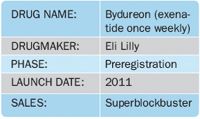
The two hottest classes are the GLP-1 (glucagon-like peptide-1) agonists and the SGLT2 (sodium glucose transporter 2) inhibitors. The GLP-1 stimulator class, being injectables, present the opportunity for drugmakers to increase convenience and compliance with longer-lasting models. Lilly's Bydureon—a once-weekly version of twice-daily Byetta—was delayed indefinitely after the FDA asked the firm to run additional tests of cardio and kidney risks that may result from higher-than-expected levels of the extended-release drug in the blood. Meantime, Novo Nordisk, the longtime diabetes shop par excellence, launched the GLP-1 to beat this year, once-daily Victoza. GSK's longer-acting Phase III GLP-1, Syncria, may succeed as a once-weekly injectable, but its second-rate efficacy is likely to limit its use.
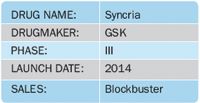
The oral anti-SGLT2 molecules target an intestinal protein that ferries glucose to the kidney, where 90 percent is reabsorbed, and instead reroutes and expels it through the urine. AstraZeneca/BMS's Phase III dapagliflozin is the front-runner among anti-SGT2 contenders, with recent data showing that in conjunction with metformin it is as effective as glipizide plus metformin, but causes the loss of seven pounds compared to a three-pound gain by its opponent. AZ/BMS are shrewdly developing a fixed-dose dapagliflozin/metformin combo to maximize its convenience. J&J, which like Merck is increasing its investment in cardiovascular and metabolic R&D, is testing its own anti-SGLT2, canagliflozin, in a 10,000-patient Phase III trial.
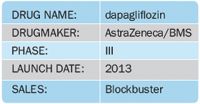
"There is a huge number of targets and compounds, including longer-acting insulins," says Karachalias. "Many companies are taking a scattershot approach to hit every molecule and see what comes out the other side."
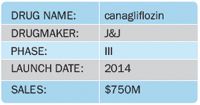
Obesity: The 10 Percent Rule
The legacy of fen-phen's and accomplia's disastrous side effects casts a long shadow over the dream of a pill that melts away fat. This year has been especially dark for obesity drugs: one standby was yanked from the market and last month, Arena's lorcaserin and Vivus' Qnexa each went before the FDA advisory firing squad only to have their one-year Phase III data shot down. In both cases, the FDA asked for two-year trials—to allow for a more realistic amplification of any potential safety signals, especially given the fact that obesity drugs, however narrowly indicated, have a curious tendency to become mass-market products. "At the FDA meetings, the body language of the committee was worse for lorcaserin than for Qnexa," says Alan Carr, a Needham & Co. analyst.
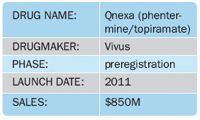
Qnexa takers in Phase III trials lost an average of 10 percent of their body weight—twice the minimum FDA requirement. Average pounds dropped by people on Orexigen's Contrave, which has its day in the FDA sun this month, was 5 percent. Lorcaserin failed to hit even that mark. Most analysts expect lack of efficacy to combine with an abundance of adverse-events risk to sink all three agents. But Ben Weintraub, director of research at Wolters Kluwer Pharma Solutions, begs to differ, spying a sunny sky for both Contrave and, especially, Qnexa. "Losing 10 percent of body weight is a significant accomplishment, and additional safety data will likely satisfy the FDA's concerns," he says. The drugs may be tightly restricted to obese people with cardiovascular problems who face an early death.

But three strikeouts would mark the start of a long and silent post-season in the weight-loss field. "It will be years before we see another obesity drug," says Carr.
Alzheimer's: A Disease at a Crossroads
"Alzheimer's is the black hole of R&D," says Wolters Kluwer's Ben Weintraub. "It's the only big disease left that is basically untreatable." Since 2003, more than 10 much-hyped compounds have bitten the dust. Almost all targeted the protein amyloid-beta, the hallmark plaque long thought to cause the disease's devastation of brain matter. But experimental agents that slow or stop the amyloid buildup have stubbornly shown no cognitive or memory benefit in patients. Last summer, the amyloid hypothesis hit a crisis point when a Phase III Lilly drug was shown to do a great job removing the plaque—only to result in a negative clinical effect. Two top Harvard Alzheimer's experts published a paper promoting the inevitable, if heretical, hypothesis: Does amyloid protect rather then destroy neurons?

Ben Weintraub, Director of Research, Wolters Kluwer Pharma Solutions
There is a growing consensus that by the time amyloid buildup is detectable, the disease has likely progressed too far to be modified. Effective treatment must begin much earlier, but so far no biomarker has been discovered to identify vulnerable patients. And with the association between surrogate markers and clinical benefits increasingly in doubt, the FDA is currently at a loss when it comes to evaluating the efficacy of new drugs. Drugmakers are understandably discouraged at the prospect of progressing yet another risky molecule, given the fact that Phase III Alzheimer's trials are among the longest, hardest, and most expensive in pharma R&D. "Companies are forced to do proof-of-concept in Phase III because Phase II trials are too small and there are no acceptable animal models," says Alan Carr.
Bapineuzumab (bapi), a monoclonal antibody developed by Elan and Wyeth (now J&J and Pfizer), may win FDA approval by sheer dint of its drugmakers' refusal to shelve it. A passive immunotherapy that triggers amyloid antibodies, bapi reduced plaques by 25 percent but flunked midstage efficacy tests—except in a subset of patients who lacked a specific mutation. The determined J&J/Pfizer group has launched 14 Phase III trials with a total of 10,000 patients. Recently, researchers made the intriguing finding that bapi may show some clinical benefits because of an indirect downstream effect: it appears to lower the amount of tau, Alzheimer's No. 2 surrogate marker, in spinal fluid.
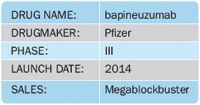
Despite its recent setback, Lilly is full steam ahead with its Alzheimer's program, one of the industry's largest. Its new lead product is a second amyloid-targeting Phase III compound, solanezumab, a monoclonal antibody that sucks up amyloid before it can form plaque deposits.
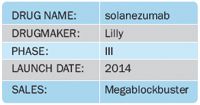
EnVivo Pharmaceuticals is testing EVP-6124, a partial a7 nicotinic receptor agonist that appears to stimulate neurons, increasing the alertness effect of the neurotransmitter acetylcholine. If this effect pans out, EVP-6124 may be given in tandem with current cholinesterase inhibitors, which increases levels of acetylcholine, potentially allowing for lower doses and fewer side effects.

The outlier in the late-stage pipeline is Baxter's Gammagard, an IV immunoglobulin containing amyloid-beta antibodies, which emerged as an Alzheimer's contender after a retrospective analysis revealed that people previously treated with the passive immune therapy had 42 percent less risk of developing the disease. A Phase II study showed significant benefits in three measures—cognitive, functional, and neuroimaging—a first for any Alzheimer's trial. Two Phase III trials are ongoing.
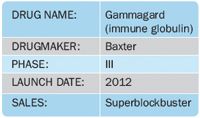
Meantime, the need for new drugs intensifies as more and more Baby Boomers live into advanced old age. The global market is estimated to be worth $20 billion by the end of the decade. "This is a time of major soul-searching in the field," says Dr. Murali Doraiswamy, an Alzheimer's researcher at Duke University.
Hepatitis C: Another Protease Revolution
The providential similarities between HIV and the Hepatitis C virus (HCV) have enabled researchers at the level of viral dynamics to apply their crisis-driven know-how about designing drugs to target specific proteins and enzymes on the first retrovirus to that of the second. And as with HIV in the mid-'90s, the launch of a new class of protease inhibitors is set to transform HCV treatment over the next decade, with kinder, gentler oral antiviral cocktails that will increase success rates from 50 percent to 75 percent while halving the current onerous course of treatment. "The pipeline has about 100 molecules designed to hit all these new targets—protease, polymerase, RNA-binding proteins," says Matthias Gotte, a virologist whose lab at McGill University tests old compounds for their prowess at outwitting the replication and resistance of HIV, HCV, and herpes.
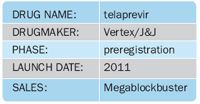
Vertex's telaprevir is expected to be the first protease out of the FDA gate early next year, followed by Merck's boceprevir by late 2011. Both drugs boast superior efficacy, and their side effects are modest compared to the standard of care: a 24- to 48-week course of weekly injections of interferon boosted by ribavirin, with its 50 percent cure rate due in part to the severe malaise triggered by the immune stimulator. Telaprevir has not only the front-runner's advantage but a slight edge in efficacy. Analysts anticipate a breathless launch by Vertex and Merck alike, and projections of $2.5 billion in annual sales by 2013 for telaprevir are widely shared.

As second fiddle, boceprevir will require standout post-marketing data to grab a heaping piece of a global HCV market expanding to $8 billion by 2014 as a growing number of the 220 million people infected with the virus access diagnosis and treatment. Still, a physician survey by Datamonitor found that 46 percent expect to prescribe telaprevir (with standard of care) to newly diagnosed patients, compared to 26 percent who will choose boceprevir.
"There is still big room for improvement in this class because both drugs have to be dosed three times a day," says Mansi Shah, a Datamonitor analyst. Nipping at their heels is J&J's Phase II protease, TMC435, poised to become the first once-daily treatment. Boehringer Ingelheim, Bristol-Myers Squibb, Gilead, and Roche all have promising protease in Phase II. Because HCV is quick to develop resistance to this class, the most potent, fastest-clearing molecule is likely to seize first-line status.
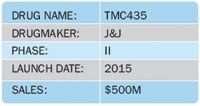
But the HCV treatment revolution will be in full swing only when an all-oral combination retires IV interferon for good. To that end, each of these six Big Pharmas are also chasing a first-in-class polymerase inhibitor—last month, Roche took the lead by licensing Pharmasset's midstage polymerase, RG7128—and are already testing protease/polymerase dual therapies in Phase II. But the polymerase class poses its own drug-design challenges: Although it is almost free of resistance, one after another targeted molecule has been doomed by high toxicities.
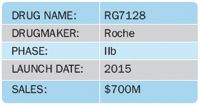
After preliminary data was recently released by BMS at the annual liver-disease conference, Gilead and Vertex stirred worries that a protease/polymerase duo alone lacks sufficient potency for sustained viral control, suggesting that the addition of ribavirin for a triple-drug viral punch will be the gold standard until a third viral protein is pierced or an inhaled—and much milder interferon—comes along. Still, the progress in HCV will bring the pharmaceutical industry glowing global headlines in 2011. Right now thousands of patients with chronic infection and failing livers are literally counting the days until their doctors can write their first scrip for these likely lifesaving drugs.
HIV: Better Combos and Classes Keep Coming
The Holy Grail of the HIV community is a cure, while pharma persists in turning out new drugs—a critical need because with lifelong multidrug treatment the standard of care, many people with HIV risk running out of options due to resistance, toxicity, or price. The new class of integrase inhibitors is the main event on the calendar, as Gilead's elvitegravir and ViiV Healthcare's GSK 1349572 come online in 2013 and 2014, respectively. Along with Merck's first-in-class Isentress, these molecules, which thwart the virus' effort to integrate its genome into the host cell's DNA, have the potential to disrupt the $10 billion market currently in the hands of Gilead's megablockbuster fixed-dose combinations.
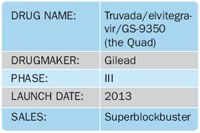
"Most of industry's focus right now is on second-generation integrase inhibitors," says McGill University's Matthias Gotte. "It's the only new target that is panning out, and coming up with new and better versions of protease inhibitors and the other classes is generally viewed as not cost-effective."
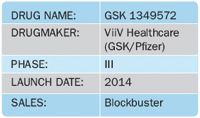
With no better efficacy than Isentress, and also sharing the same resistance profile, elvitegravir suffers from "too little, too late" syndrome. But Gilead has shrewdly bundled it in a new adherence-friendly four-in-one pill dubbed the Quad, which, along with the biotech's upcoming Truvada/riplivirine fixed-dose duo, will establish the one-pill cocktail as the gold standard. By contrast, the integrase blocker in development at ViiV, the GSK/Pfizer HIV joint venture, has gained "next big thing" status for its superior potency and unique resistance pattern. ViiV is already behind schedule to meet its stated goal of one new drug a year, but its investment in HIV R&D has the potential to revitalize this formerly on-a-mission field as it tests new non-nucleosides and new CCR5 inhibitors—classes of dwindling interest to competitors.
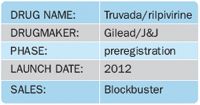
Depression: A Not-So-Rosy Outlook
"Depression is going through a challenging time," says Datamonitor analyst Ben Greener. "It's a mature market and reaching the patent cliff." Led by Prozac and Effexor, the market has been flooded with molecules that treat depression and anxiety by targeting two neurotransmitters, serotonin and norepinephrine. French pharma Servier took a very different approach with Valdoxan, a dual action molecule that combines a melanotergic receptor agonist and a 5HT2C antagonist, targeting the neurotransmitters dopamine and noradrenaline.
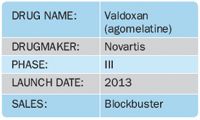
Already marketed in the EU, where uptake has been slow, its main selling points have been that it is fact-acting, free of the sexual side effects common to the serotonin-reuptake inhibitors, and a sleep promoter. But a recent analysis of pooled data from four head-to-head trials showed that Valdoxan beat Prozac and Effexor by a small but significant margin. With a growing need for boosters that jump-start a failing regimen, blockbuster sales are predicted for Valdoxan, according to Datamonitor.
Nicotine Addiction: What Lights Up the Field
The market for anti-smoking products exceeds $2 billion, but their superiority over cold-turkey quitting remains controversial. The first vaccines are set to offer a new weapon in the fight against nicotine addiction. Long-lasting single injections, these new vaccines remove the hurdle of daily adherence while sparking the immune system to produce nicotine-specific antibodies that aggregate nicotine in the bloodstream, resulting in a nicotine complex too large to cross the blood-brain barrier where the reward system awaits. Denying the pleasure of the fix may indirectly help minimize the craving that accompanies quitting smoking.
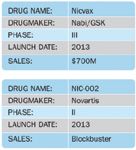
Cancer: On Target Once More
With the advent of genomics and targeted therapy, bringing cancer to heel once seemed a viable, if distant, goal. But since then, Herceptin and Gleevec, models of the single mutation approach, have proved the exception rather than the rule. Over the past year or two, a handful of Phase III failures, including megablockbusters like Avastin and Sutent in trials for all kinds of common tumors, indicate that targeted therapy is generally a blunt instrument for the simple reason that most cancers are mutlifactorial, driven by abnormalities in many genes and pathways at the same time.
According to cancer geneticist Garth Anderson of the Roswell Park Cancer Institute, most common tumors are ruled by what he calls "genomic instability"—thousands of genetic errors causing massive DNA damage. The result is evident in the current state of cancer treatment: Tumors get a little smaller for a little while, and the benefit to the patient is measured in months.
The FDA and payers are pushing back at the barrage of drugs whose bar is so low and whose price is so high. And some pharmas are hedging their bets, investing increasingly in better, safer versions of chemotherapy. Still, 2011 will usher in four or five truly breakthrough—and, yes, targeted—therapies for cancers that have until now gone largely untreatable.
Topping the list is Sanofi-Aventis' iniparib, aiming to become the first treatment for triple-negative breast cancer, the most aggressive type and one that assaults 15 percent to 20 percent of all women with the disease. This molecule targets the PARP enzyme used by cancer cells to repair the damage to their DNA done by chemotherapy—thereby enhancing its effectiveness. When combined with standard chemo, iniparib increased overall survival to 12.3 months, almost five months longer than the chemo-only group. "That magnitude of the survival advantage is unusual in breast cancer and in metastatic tumors in general," says Dr. Joyce O'Shaughnessy, lead investigator of the study and co-director of the Breast Cancer Research Program at Baylor Charles A. Sammons Cancer Center.
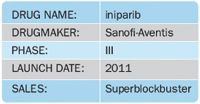
Bristol-Myers Squibb's ipilimumab (ipi) is on deck to become the first treatment for malignant, or advanced, melanoma, one of the deadliest of cancers. A monoclonal antibody that amplifies the body's immune response by blocking a specific molecule on the surface of T cells, ipi is the first drug to show survival in Stage 3 and 4 melanoma. In Phase III trials, 23 percent of ipilimumab patients were alive after two years compared to 14 percent on standard treatment. Yet drugs that switch the immune system into high gear can have grave complications. After fast-tracking ipi, the FDA has postponed its big day until March 2011—to the fury of many patients.
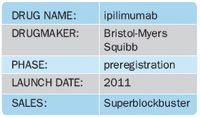
Seattle Genetics' antibody drug conjugate (ADC) technology has at long last yielded a promising treatment for two types of rare lymphomas. SGN-35 (brentuximab vedotin) is an ADC delivery system that releases its anti-cancer payload upon entering the tumor. The FDA granted orphan drug designation to SGN-35 for the treatment of Hodgkin's disease and anaplastic large-cell lymphoma. In Phase II, 11 of 45 Hodgkin's patients saw a complete remission while six others received a partial remission. Based on these and other positive results, Seattle Genetics, in partnership with Takeda's Millennium, will file a BLA for both indications in the first half of 2011.
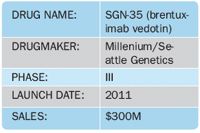
Exelixis is developing a compound that shows exceptional effects in bone cancer, for which no treatment exists. XL 184 appears to target the cancer in two ways, both by cutting off its blood supply and by blocking the MET protein that spurs tumor growth. New data from a Phase II prostate cancer study shows that 19 of 20 patients who had cancer that had metastasized to the bone had lesions shrink or disappear. "There's really no precedent for another drug that does this," says Dr. Matthew R. Smith, a prostate cancer specialist at Massachusetts General Hospital. This data may cause regret at GSK and BMS, both of whom passed on licensing Exelixis' lead candidate.
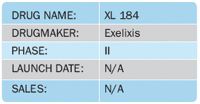
Non-Small-Cell Lung Cancer: Targeting Pathways and Patients
Although the most common cancer worldwide, lung cancer remains poorly treated, with the highest mortality rate. Non-small-cell lung (NSCL) cancers account for 85 percent of all lung cancers, and despite the fact that they are relatively slow growing, they remain highly lethal because they are often undetected until in an advanced stage and therefore inoperable. Average survival even after treatment is about a year.
NSCL is a diverse group of cancers fueled by a wide range of genes and pathways, resulting in a big target for many pipeline products. Many, but by no means all, NSCL cancers are set in motion by one of two oncogenes: EGFR or KRAS. The response rate to treatment of EGFR-fueled tumors is an impressive 60 percent; KRAS-caused cancers are largely immune to targeted EGFR therapies.
Hundreds of targeted therapies are being tested against NSCL cancers—the need is great, the targets are many, and the bar is low. Three late-stage candidates illustrate the great expectations and growing pressures of the oncology R&D scene.
Pfizer's crizotinib is yet another of the late-stage pipeline's targeted therapies that have taken researchers and physicians by storm this year. The kinase inhibitor blocks the expression of the ALK (anaplastic lymphoma) gene, which, when awry, is the single cause of one type of NSCL cancer. On the model of Herceptin and Gleevec, crizotinib shows extraordinary efficacy at shrinking or at least stabilizing these tumors—72 percent in a Phase II study of 82 people. Some have gone more than 15 months without disease progression.

Unfortunately, only about 2 percent to 7 percent of all NSCL tumors are driven by the ALK mutation—some 10,000 patients in the US, generally younger nonsmokers. Fast-tracked by the FDA, crizotinib's NDA will be filed in 2011 along with a gene diagnostic test that Pfizer is developing with Abbott. Personalized medicine takes another baby step forward.
Boehringer Ingelheim's Tovok (afatinib) may offer the first, albeit short, lifeline to patients with EGFR-fueled tumors resistant to standard treatments. Researchers theorize that the mutation of a second gene, T790M, is what clinches drug failure. New data from a Phase IIb/III trial of 585 patients with advanced NSCL cancers and both mutations show that those taking afatinib had longer progression-free survival than those on placebo, 3.3 months versus 1.1 months. Yet somewhat perversely, afatinib lost out to placebo in terms of overall survival, 10.8 months versus 12 months. These conflicting results beg the question that regulatory agencies and public and private payers are increasingly asking: Does this cancer drug offer sufficient clinical value to merit the inevitable five-digit price tag?
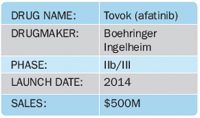
"If I was a health minister, I could see why it might be difficult to justify spending money on this," said Dr. David Kerr, president of the European Society of Medical Oncology, where the data were presented. "We need to increase the sharpness of end points or we need to explain to patients and governments about overall survival." Boehringer Ingelheim is running two Phase III trials of Tovok as a first-line treatment in the EGFR subgroup of patients.
Necitumumab, ImClone's follow-on of its megablockbuster Erbitux, is in Phase III trials for advanced NSCL cancer. "It's more selective and more active on the EGRF pathway than Erbitux, and that may well translate into greater efficacy," says Wolters Kluwer's Ben Weintraub. A fully human monoclonal antibody where Erbitux is part man, part mouse, necitumumab may well also offer a better safety profile. After squabbling over the rights to the son of Erbitux, Lilly and BMS are sharing the risk of the development program, starting in NSCL cancer and expanding into other tumors. Analysts have observed that by 2015, when necitumumab will face the FDA music, comparative effectiveness pressures will likely force the son of Erbitux to go head to head against its father.
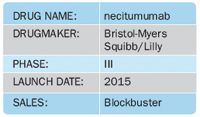
Multiple Sclerosis: The Advent of the Orals
The $8 billion dollar multiple sclerosis (MS) market is set to double the number of available treatments in the near future, with a dramatic switch from injectables to oral medications. On the heels of Novartis' first-to-market Gilenya, whose uptake has exceeded all expectations, Merck KGaA, Teva, Sanofi-Aventis, and Biogen Idec all have MS pills prepping for a date with the FDA. Developed by MS powerhouse Biogen, BG-12 (dimethyl fumarate) triggers the Nrf2 pathway, defending against oxidative stress that can cause inflammation and injury to neurons and the CNS myelin, which, in turn, trigger MS symptoms. Phase IIb data also showed that B-12 cut the number of brain lesions in patients with relapsing-remitting MS by 69 percent compared to placebo.
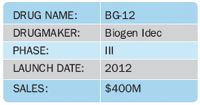
Two Phase II injectable monoclonal antibodies also evince disease-modifying promise. Roche's ocrelizumab, a monoclonal antibody related to rituximab for rheumatoid arthritis (RA), depletes B cells, which play a role in the autoimmune destruction caused by MS. In a Phase II study, the high dose of ocrelizumab reduced the number of brain lesions by 96 percent compared to placebo, the low dose by 89 percent. The relapse rates fell by 80 percent and 73 percent, respectively.

Genzyme's alemtuzumab, already sold as Campath for chronic lymphocytic leukemia, shows exceptional efficacy, reducing the relapse rate of patients in a Phase II study by 87 percent after five years, compared to the standard of care. The monoclonal antibody targets the CD52 protein on the surface of certain T cells, B cells, and other lymphocytes, which MS mistakenly turns against neurons and myelin. Over the ensuing several years, these immune cells grow back—theoretically free of the MS stamp. Should alemtuzumab win approval, Genzyme (or Sanofi-Aventis, if its hostile takeover succeeds) will face the ethical and PR quandary of pricing a new drug for MS that is already available as a cancer drug, the quandary being that MS patients need only eight infusions over four years, about $10,000 at Campath's rate. Rival MS treatments cost $30,000 or more.
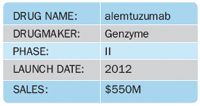
Lupus: How Big will Benlysta Become?
The headline news in autoimmune disease R&D is the launch of the first new treatment for lupus in half a century. Current treatment is limited to steroids and other immunosuppressants, whose side effects can be worse than the symptoms of the disease. Says Decision Resources analyst Michael Latwis: "Lupus has been a very challenging therapeutic area for decades, in part because its symptoms vary so widely that clinical efficacy is exceedingly hard to establish." Yet Human Genome Sciences/GSK's Benlysta (belimumab) was approved by an FDA advisory committee in November—to the cheers of many patients who had testified to their need of the novel (if less than overwhelmingly efficacious) therapy.

A monoclonal antibody delivered by monthly infusions, Benlysta targets an immune protein called B lymphocyte stimulator (BLyS) that causes the hyperactivity of tissue-destroying B cells. BLyS was discovered by Human Genome Sciences in its vast trove of human genes in the glory days of the genomics revolution.
Despite inconsistent results in Phase III trials, the FDA is almost certain to wave Benlysta through to market. "It may only help a small number of patients," says Wolters Kluwer's Ben Weintraub. "Once again, marginal efficacy weighed against major unmet medical needs is likely to carry the day."
Rheumatoid Arthritis: JAKing Down Inflammation
In the race to market the first oral drug to compete with high-priced injectables for rheumatoid arthritis (RA), Pfizer's tasocitinib has the home-stretch lead over Rigel, Vertex, and Incyte. All four contenders are Janus-associated kinase (JAK) inhibitors, a new class of molecules with anti-inflammatory activity that puts the brakes on RA's joint destruction. In a 600-patient Phase III trial, Pfizer's twice-daily anti-JAK pill reached two of three of its goals, reducing symptoms and increasing functionality, but failing to best placebo in number of remissions. Three out of four patients saw a decrease in pain and inflammation. However, the drug raised the levels of both good and bad cholesterol, a regulatory red flag, especially for drugs used long term by elderly patients. As a first-to-market RA pill, tasocitinib could garner $2 billion annually in sales, says Sanford C. Bernstein & Co's Tim Anderson.
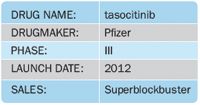
Vaccines: Progress in Preventing Bad Bugs
Long on the sidelines of pharma R&D, vaccine development is moving to center stage as most of the big pharmas diversify, spreading their risk among the full gamut of revenue sources. And it helps that the vaccine market—$22 billion in 2009—is growing at an annual rate of 10 percent, reaching $35 billion by 2014, according to a new Kalorama Information report. Vaccines are also cost-effective: Every dollar spent on vaccination returns between $7 and $20 in avoided costs related to disease management.
The three giants in vaccine development—GlaxoSmithKline, Sanofi-Aventis, and Merck—all have late-stage candidates with enormous potential to improve health in the developing world.
GSK has spent two decades and $500 million in an effort to create the first vaccine to prevent malaria, the mosquito-borne parasite that kills more than 1 million children a year, mainly in Africa and Asia. The newest version, Mosquirix, is in early Phase III trials in 12,000 children in seven African countries (4,000 more children are needed for full enrollment). The first data reports on safety and efficacy are due at the end of the month. In previous trials, Mosquirix achieved a protection rate of only 45 percent—but given the disease's destructiveness, even partial protection will save the lives of many infants and young children. Still, Mosquirix must step it up because the Malaria Vaccine Initiative has set the bar at 50 percent immunization.

Mosquirix was engineered by fusing a slice of the outer protein of a very deadly malaria parasite type with a slice of Hepatitis B virus and an adjuvant chemical to boost response. The vaccine requires three injections for optimal protection, but even a single dose will produce sufficient antibodies to prevent severe disease. Anticipating a review as early as 2012, the British firm has vowed to make Mosquirix available to any nation that requests it, asking only a 5 percent return on its cost.
Sanofi Pasteur, Sanofi-Aventis' venerable vaccine innovator, has developed the first vaccine apparently potent against all four serotypes of the dengue fever virus. There is no specific treatment for dengue, and some 2 million children every year suffer a severe infection, especially in Latin America and Asia. The French firm is so confident in the data coming from its global Phase III trials that it has already broken ground on a $500 million manufacturing plant for the blockbuster-to-be ChimeriVax set to launch in 2014.

Merck is developing a vaccine, V710, against Staphylococcus aureus licensed from Intercell and based on an antigen found on almost all types of the bacteria. S. aureus is the leading cause of hospital-acquired infections, and almost half of its strains are resistant to available antibiotics. V710's potentially broad spectrum approach may prove sufficiently effective as to make it the first vaccine against the superbugs. New data from a Phase II study of 200 patients with end-stage renal disease undergoing hemodialysis—and therefore at high risk of infection—confirmed that V710 induced a sustained immune response.

Novartis' anti-meningitis B candidate is another vaccine with very broad antibody coverage. 4CMenB confers protection against most of the geographically and genetically diverse strains of the meningitis B bacteria, including 85 percent of adults and 75 percent of children. The Swiss firm is donating its meningitis B assay platform worldwide in order to speed detection of culprit strains susceptible to the vaccine, which is expected to roll out in 2013.
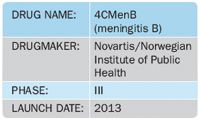
Bavarian Nordic, the Danish vaccine specialty shop, is building up its biodefense portfolio with Immavune, a novel Phase III vaccine for smallpox that shows exceptional safety, even in the immune-compromised. It aims to combine Immavune with MVA-BN, a novel preclinical candidate against anthrax, to provide populationwide protection against two of the top bioterrorist threats.

Sales figures in info boxes are Pharm Exec's projections; Blockbuster = $1 billion, Superblockbuster = $2 billion, Megablockbuster = $3 billion-plus; N/A = Not Available
Much of the research in this article was completed using the Wolters Kluwer Health AdisInsight database. For more information go to www.wkhealth.com
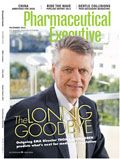
Addressing Disparities in Psoriasis Trials: Takeda's Strategies for Inclusivity in Clinical Research
April 14th 2025LaShell Robinson, Head of Global Feasibility and Trial Equity at Takeda, speaks about the company's strategies to engage patients in underrepresented populations in its phase III psoriasis trials.
Bristol Myers Squibb’s Cobenfy Falls Short in Phase III Trial as Add On Therapy for Schizophrenia
April 23rd 2025In the Phase III ARISE trial, Cobenfy administered as an adjunctive treatment to atypical antipsychotics for patients with inadequately controlled schizophrenia did not achieve statistically significant improvements.
Key Findings of the NIAGARA and HIMALAYA Trials
November 8th 2024In this episode of the Pharmaceutical Executive podcast, Shubh Goel, head of immuno-oncology, gastrointestinal tumors, US oncology business unit, AstraZeneca, discusses the findings of the NIAGARA trial in bladder cancer and the significance of the five-year overall survival data from the HIMALAYA trial, particularly the long-term efficacy of the STRIDE regimen for unresectable liver cancer.
Regeneron, Roche Launch Major US Expansion Plans to Meet Growing Demand for Biologics and Innovation
April 22nd 2025With combined investments exceeding $53 billion, both companies are deepening their US presence through expanded biologics production, gene therapy capabilities, and next generation R&D centers.
Expanding Immune Response Testing to Support Vaccine Development
April 22nd 2025Nigel McCracken, chief operating officer, Virax Biolabs, discusses the expansion of its ViraxImmune platform into areas such as transplant monitoring, vaccine efficacy, latent virus reactivation, and CAR T cell therapy.